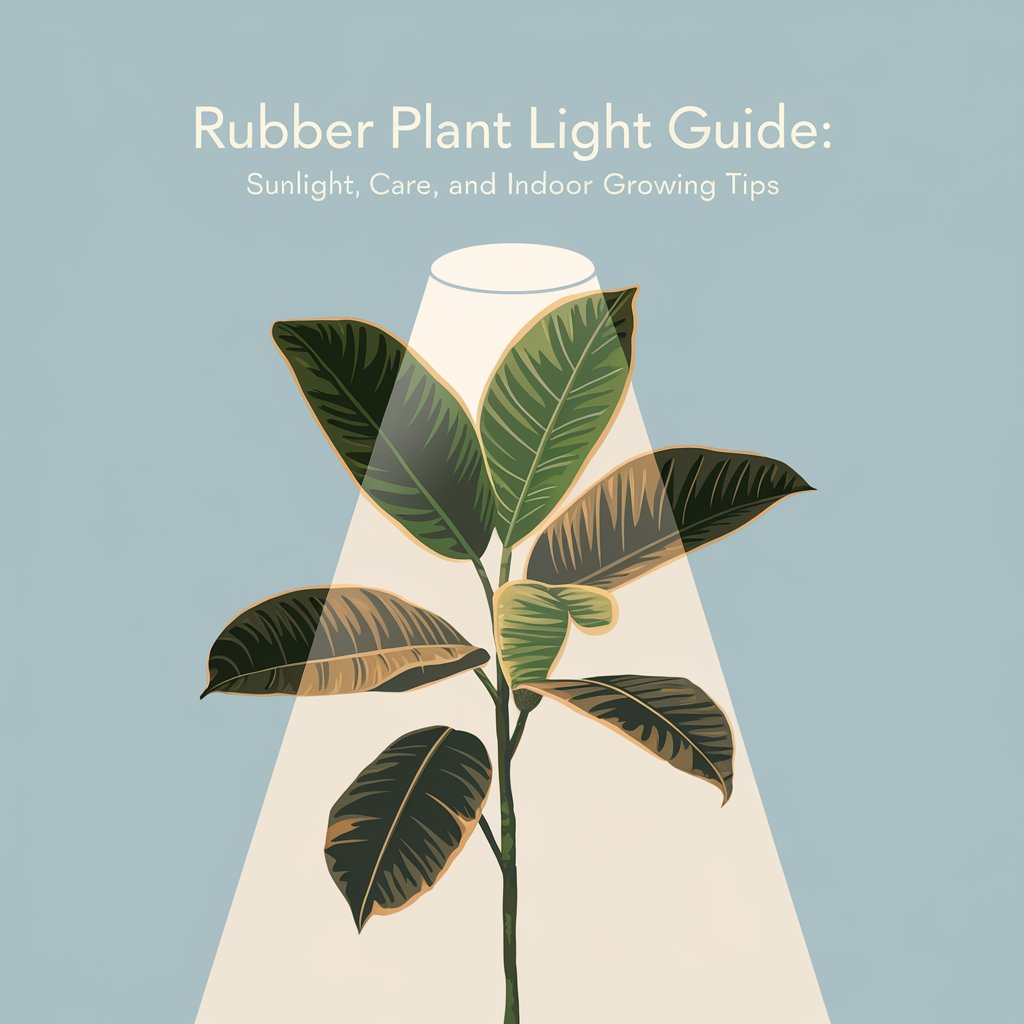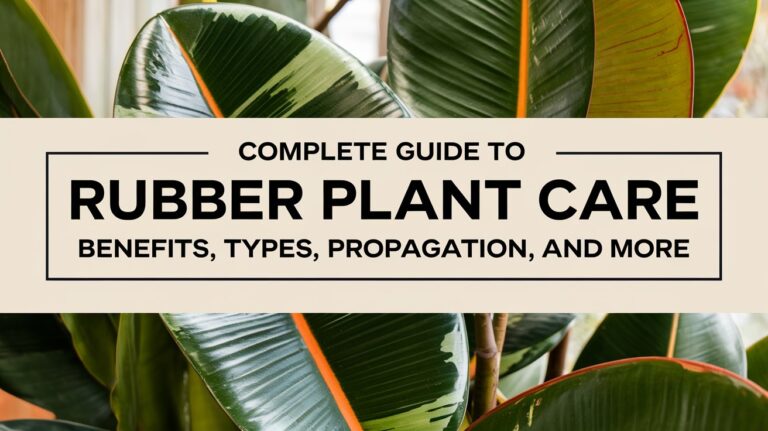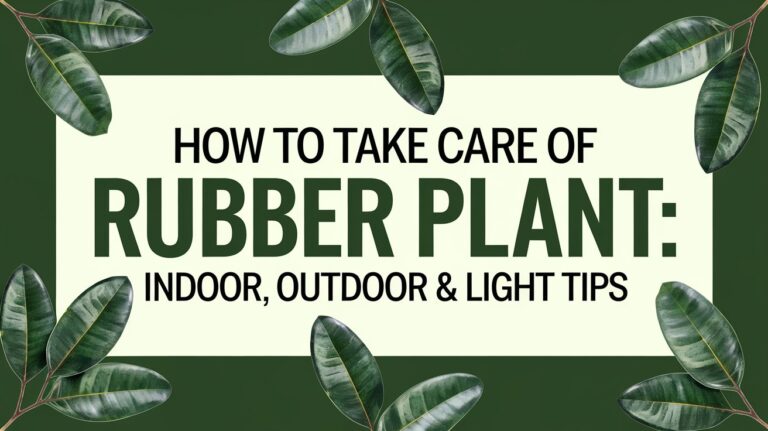If you’re like me, you’ve probably fallen in love with the gorgeous, glossy leaves of a Rubber Plant (Ficus elastica). These beauties make wonderful indoor houseplants, but as with any plant, there’s a secret to keeping them thriving—especially when it comes to light. So, do Rubber plants need sunlight? Yes, they absolutely do! But the amount and type of sunlight they need might surprise you. In this post, I’ll walk you through everything I’ve learned about rubber plant care lights, including how much light they need, how to care for them based on their light exposure, and what happens when they don’t get the right kind of light.
Understanding Rubber Plant’s Light Needs: Why It’s Crucial
First off, let’s answer the burning question—does a rubber plant need direct sunlight? While Rubber Plants do enjoy bright light, they don’t necessarily thrive in direct sunlight. They’re native to the tropical regions of India and Southeast Asia, where they experience plenty of filtered light under the canopy of larger trees. In other words, rubber plant sunlight requirements lean more toward bright, indirect light rather than direct sunlight.
If you’re wondering, how much light does a rubber plant need? Think of it like this: they need bright, indirect light for a few hours each day to stay healthy and vibrant. Direct sunlight can actually be a little too harsh, leading to leaf burn and those unsightly brown edges we all want to avoid.
Ideal Light for Your Rubber Plant
When you first bring your rubber plant home, you might be eager to place it somewhere it gets full sunlight—don’t! Instead, I recommend putting it in a spot where it gets plenty of indirect light. A place near a bright window, but not directly in the sun’s path, works best. Think of it like placing the plant in a sunny room with a sheer curtain to filter the light. That’s the perfect environment for your rubber plant light to thrive.
So, does a rubber plant need sunlight? Absolutely, but the key is that it prefers bright, indirect sunlight over direct sunlight. If you’re growing a variegated rubber plant, the need for indirect light is even more critical—these varieties are more sensitive to intense sunlight and can get scorched more easily. I made the mistake of putting my variegated rubber plant directly in the sun once, and it ended up with a light green spot on the rubber plant leaf, which wasn’t a good sign! It’s one of those lessons I learned the hard way.
What Happens to Rubber Plants in Insufficient Light?
If your rubber plant isn’t getting enough light, you’ll notice some pretty telltale signs. What happens to a rubber plant in insufficient light? First off, the leaves will start to turn yellow. You may also notice the plant growing leggy, which means it’s stretching out in search of more light. If you’re not careful, the plant could stop growing altogether, and that’s never fun.
When I first started growing rubber plants indoors, I didn’t pay attention to their light needs as much as I should have. At one point, my rubber plant stopped growing, and I couldn’t figure out why. After a little research, I realized it was due to not enough light. Once I moved it to a brighter spot, it bounced back in no time!
Indoor Growing Tips for Rubber Plants
Now that we’ve covered the basics of rubber plant light, let’s dive into some practical indoor growing tips. Here’s what I’ve learned about how to make sure your rubber plant gets the right amount of light and stays happy.
Best Locations for Rubber Plants
If you’re looking to place your rubber plant in the best spot, aim for a south-facing window (if you have one). This is where you’ll get the brightest light. A west-facing window also works well, but you’ll need to watch for the afternoon sun, which can sometimes be a bit too much. East-facing windows are also ideal because the sunlight is gentler in the morning.
Using Grow Lights for Rubber Plants
If you don’t have access to ideal natural light, don’t worry—there’s a solution. A grow light for a rubber plant can help ensure your plant gets the light it needs. I’ve found that LED grow lights work really well for indoor plants. These lights mimic natural sunlight and can be placed a few feet away from your plant to give it the boost it needs during the darker months or in low-light areas.
Signs Your Rubber Plant is Getting Too Much Light
As I’ve learned the hard way, it’s important to find the right balance with light. Does a rubber plant need direct sunlight? Yes, but only in small doses. Too much sunlight can cause damage. Look for signs like crispy edges or brown spots on the leaves, especially in the middle or at the tips. If this happens, move your plant away from the window or consider using a sheer curtain to filter the light. These small adjustments can make all the difference.
Common Mistakes to Avoid in Rubber Plant Light Care
I’ve made my share of mistakes with Rubber Plant care over the years, and one of the biggest ones was not paying enough attention to its light needs. Here are a few common mistakes you’ll want to avoid:
- Placing your Rubber Plant in direct sunlight: As we’ve mentioned, this can lead to leaf burn and damage. Always aim for bright, indirect light.
- Not adjusting light based on seasons: In winter, the sun’s position shifts, so you might need to move your plant closer to a window or use a grow light to compensate for the lower intensity of natural light.
- Ignoring light needs for different varieties: If you have a variegated rubber plant, it’s even more sensitive to intense light. These varieties need careful placement to avoid damage.
Conclusion
To sum it up, Rubber Plants do indeed need sunlight, but they thrive best with bright, indirect light. If you’re unsure, always err on the side of caution and place your plant in a location with filtered light. Keep an eye on its leaves, and you’ll know if it’s getting too much or too little light.
If you’re growing a variegated rubber plant, be extra careful with light exposure—it needs a bit more TLC. And remember, if your plant isn’t getting enough light, you can always supplement with a grow light for the rubber plant to help it thrive indoors.
By understanding and adjusting to your Rubber Plant’s light green spot on rubber plant leaf symptoms or signs of insufficient light, you’ll be able to create a healthy, thriving indoor garden. Enjoy your Rubber Plant, and happy growing!
Hi, I’m Pritesh, the heart and hands behind Roots & Earth. My love for plants started when I was just 5 years old, planting trees alongside my grandfather. Those early experiences in the garden left a lasting impression, shaping my deep connection to nature and sparking a lifelong passion for nurturing green spaces.
With an MBA under my belt, I’ve blended my business acumen with my love for gardening, creating Roots & Earth as a way to share my knowledge and inspire others. When I’m not working in my own home garden, you’ll find me traveling to the mountains—my favorite getaway for reconnecting with the natural world.
At Roots & Earth, I’m here to guide you on your gardening journey, whether you’re a seasoned green thumb or just starting out. Together, let’s cultivate beautiful, thriving spaces that enrich our lives and the earth.




